Stuck somewhere between the dominant Just Chatting and video games, the Twitch Art category is slowly making its mark. Here’s a little exploration.
On Friday at 22:30, while France is painfully chasing the second episode of a Netflix series or a surprise speech by Emmanuel Macron, the real ones know that a successful second half of the evening is spent on Twitch. The platform is an ideal prelude to sleep, to end the day gently, as long as you avoid video game-centric streams. And what better ‘pre-sleep’ ritual than to watch artists painting, drawing, glueing, sewing or colouring more or less successful works? On Twitch, the Art category averages 12,000 live viewers for 2.1 million subscribers. Suffice to say that we are far behind other alternative categories such as Just Chatting which has an average of 350,000 viewers, or even Music (30,000 viewers). The tag still gained 84% more views in 2020 with 6.5 million hours viewed this year compared to 3.5 in 2019. Thank you confinement.
In the realm of Photoshop brushes and MSpaint drawings
At first glance, the live art is not very engaging. You see a lot of artists doodling manga characters or working on the Photoshop colour palette. But if you dig a little deeper, you can find some streams that are more original than others. There’s the Body Painting Artists corner, on the edge of the ‘beauty’ and ‘body art’ tags, who paint their entire bodies. There is also the Twitch Make Pixel Art live stream, a collective experiment in which each user can post a pixel of the colour of his or her choice every 5 seconds, which produces a sort of interactive canvas where the works are made and unmade according to the groups present.
Those who are not afraid to see the scrolling menus of the 3D Blender modeling software can also go and observe the specialists of digital works like Blakekathryn who sails the waters of the vaporwave (an artistic movement close to the kitsch aesthetic of the 90’s web).
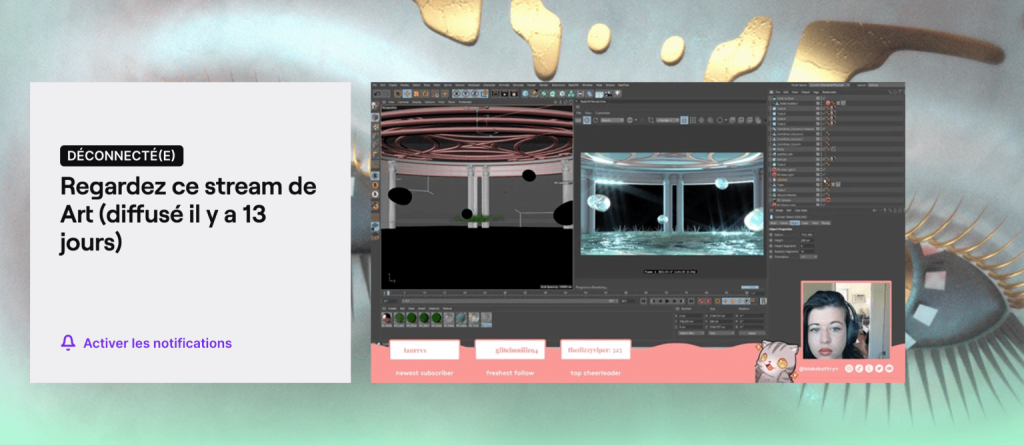
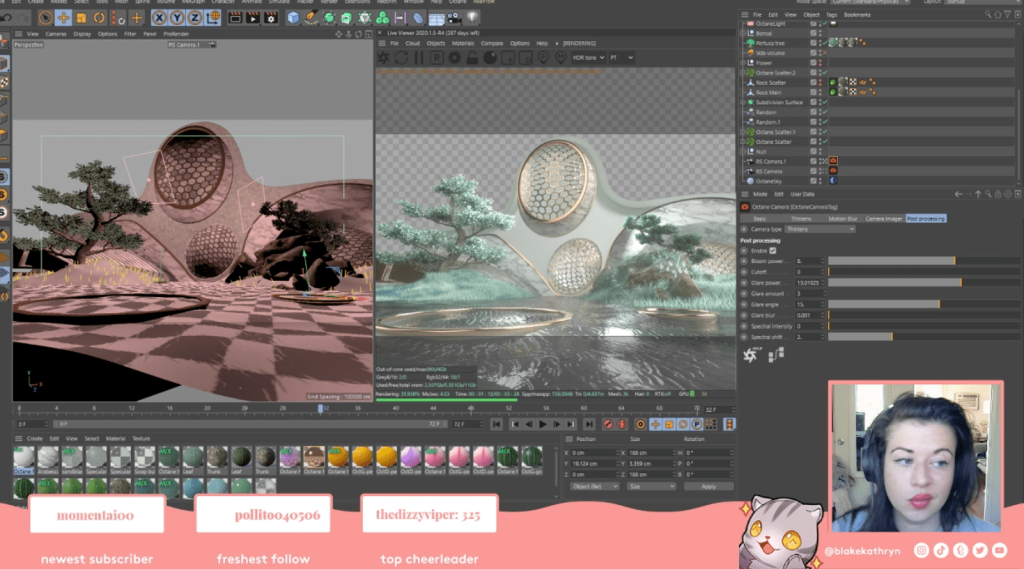
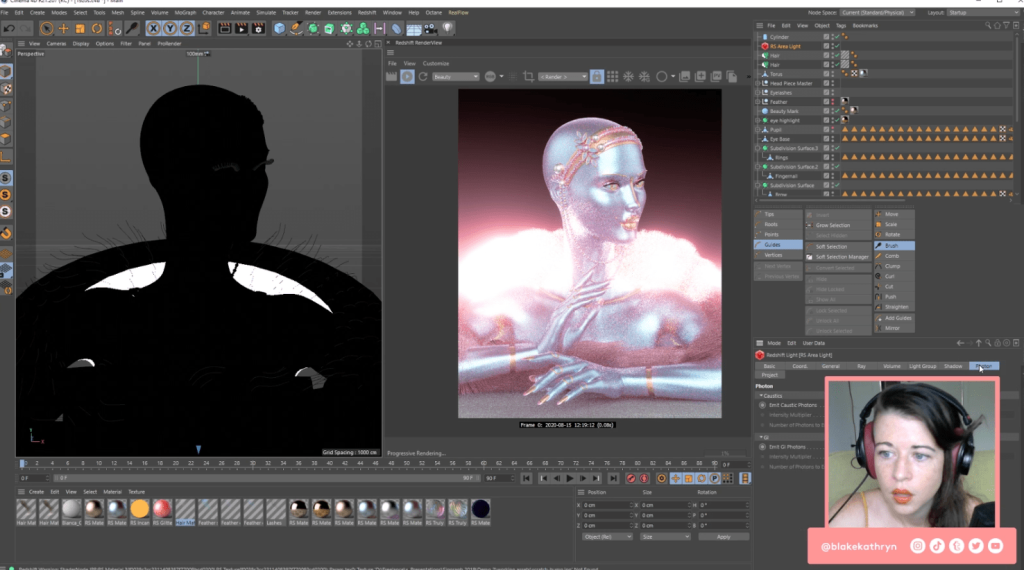
But on closer inspection, art stream aficionados also come for the ‘chill’ side of the live shows, which often turn into an intimate discussion with the artist. This is the case with LunarNisha, an MS Paint artist whose deliberately ugly drawings are made on the famous Microsoft software. Internet users come to get their dose of the absurd and stay for the playful tone of the young lady who chats while holding a stuffed animal in her arms.



In praise of slowness
It is no coincidence that the most watched channel in the category remains that of the late Bob Ross. This painter with the mythical hair hosted a show called “The joy of painting” broadcast on PBS between 1983 and 1994. With the arrival of YouTube and the ASMR culture and ‘oddly satisfying’ (a culture which consists in feeling chill thrills or well-being thanks to particular videos), he has become the object of a veritable cult on the networks. Internet users are particularly fond of his soft and calm voice, but also of the sound of brushes on the canvas and his little tips for painting beautiful clouds or pretty mountains. Most art streams are in this ASMR vibe. The obligatory lo-fi music, but also the rhythm, inevitably slow, of the work being done before the eyes of the Net user, play a big part.
Rome was not built in a day and most works that are made on Twitch can take hours, or even days, to complete. “That’s really what I wanted to offer when I started streaming a year ago”, explains David Chaban, better known as Ganeshdeux and author of manga parodying political figures like Jean-Luc Mélenchon:
“I’ve been on the Internet for a while and I’ve realised that people are used to only seeing the results of what you produce, and giving their opinion. They don’t know the slow process of creation. The idea is to show them that a page doesn’t take five minutes to draw. And that even if we make a drawing relatively quickly during the live show, it’s because we have 15 years of experience behind us that allows us to be that fast.”
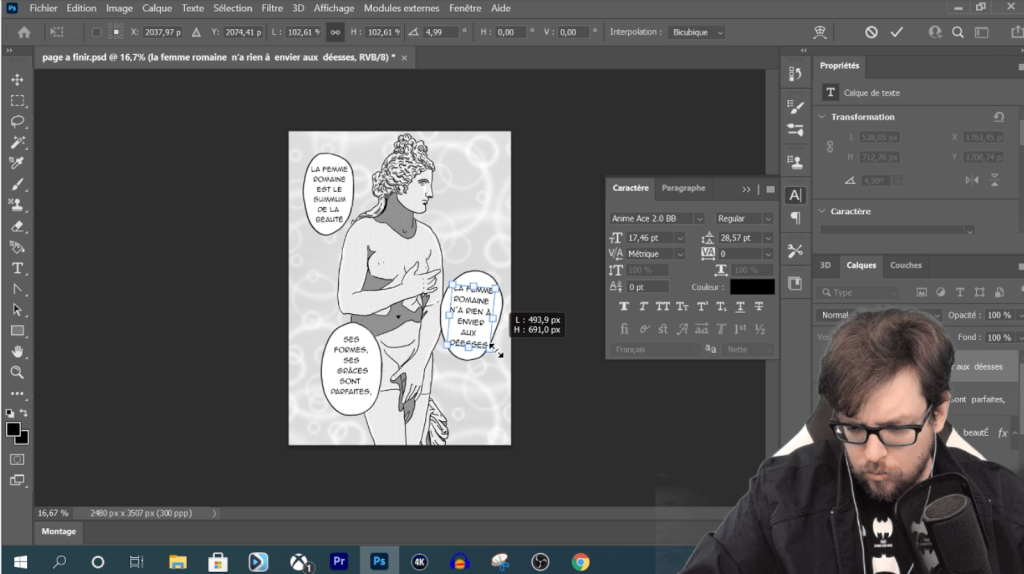
“Congratulations, artist”
As a viewer, we tune into an art stream for several reasons:
- You can have a relaxing time watching a work of art being built up bit by bit.
- You can also leave the video on in the background to feel less alone during a work session. (Just like Merve’s streams on Youtube).
- Others yet come to seek inspiration, or even the courage to overcome certain obstacles, as is the case of this Internet user who explains on the Bulledop stream:
“I love watching you paint or draw because it helps me get over my block and imposter syndrome.”
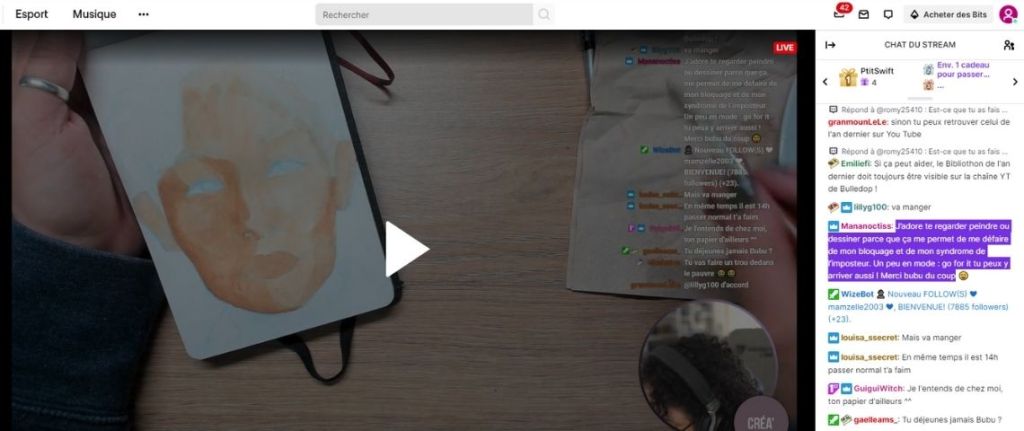
In addition to relaxation and inspiration, people also come looking for those privileged and often fleeting moments that they used to have at the signing booths. If you are a fan of the cartoonist Boulet, for example, coming to watch him draw and tell his stories, as if you were with him in his studio, offers an unprecedented feeling of proximity.
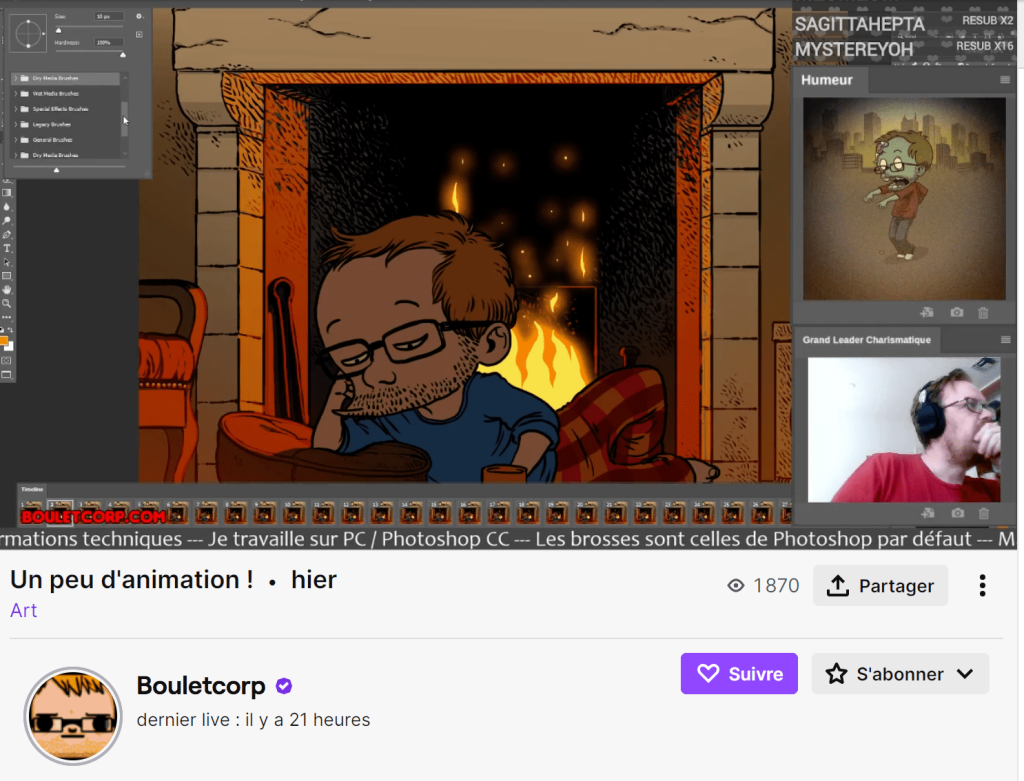
This access to an audience and this proximity are also novelties for artists who were used to creating in solitude. Thus, some see streams as a way to motivate themselves. For Eduardo Valdés-Hevia, an artist specialising in the creation of retouched photos in the “Lovecraft vein”, plugging in your camera is a very good tactic against procrastination:
“I started livestreaming my art in the hope of being more consistent and sharing the process with people. It’s not my main activity, so it’s a great motivation to keep creating”.
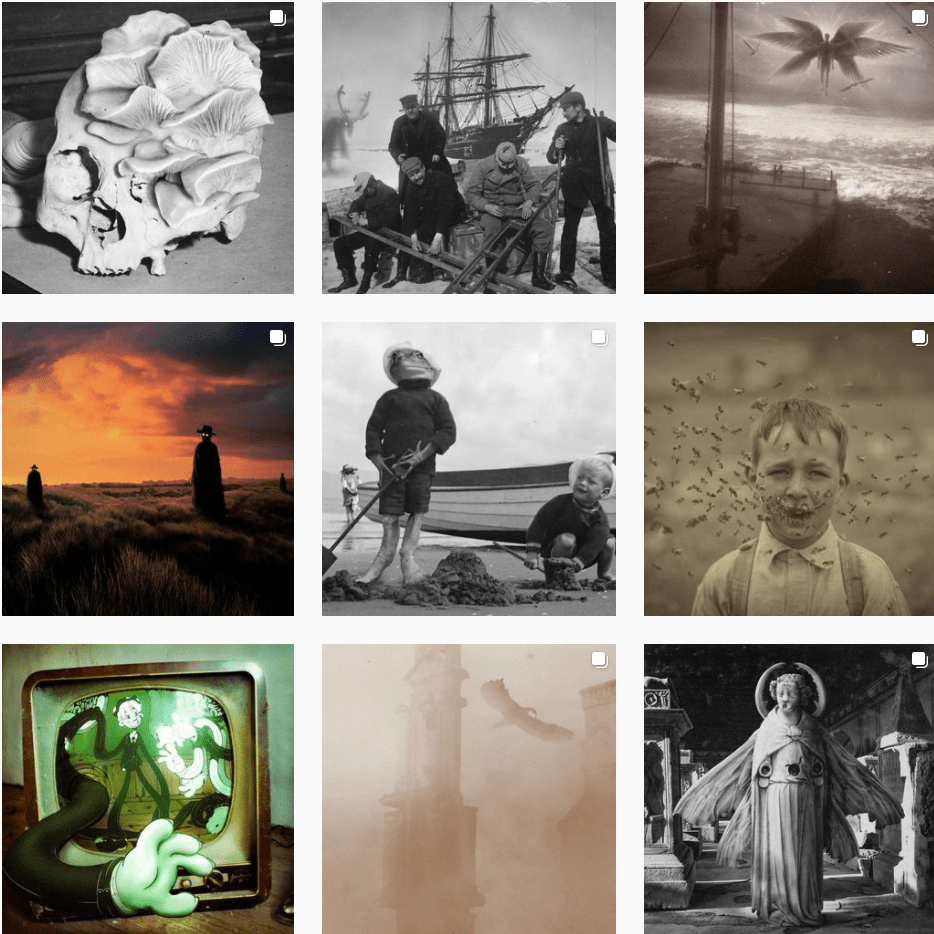
Community building and exchange are also at the centre of his streams:
“Each platform has its own way of interacting with its audience. I find Instagram very detached, as if the platform takes me away from the people who appreciate what I do. Twitter is much better for engaging in conversation, but also for joining communities of artists. But I think Twitch is the network where artists and audiences are closest, as you can have direct discussions. It’s even a great place to turn your audience into a community, or even a group of friends”
For David Chaban, who already has a community of his own on the networks, the social and marketing aspect of Twitch should not be neglected either:
“When I’m live, I tend to work on pages that I think are interesting and that won’t spoil the story too much. The idea is also to tease the work a bit and make people want to get it”
He, who before the pandemic greatly enjoyed IRL meetings with the public, now uses the platform to keep in touch:
“What I really miss are conventions like Paris Manga. I did a lot of signings for people and it was an opportunity to chat with them. Twitch really helps make up for that lack of interaction”
Is this a good situation, being a cartoonist on Twitch?
The fact remains that being a professional artist on Twitch is sometimes (often?) as difficult as being an ‘IRL artist’. In a post written a year ago on the reddit /r/Twitch, a streamer wonders why it is so difficult to get his audience to take off despite the quality of his work. The answer he received from a user contains all the issues related to the inequalities of audience on the platform:
“Art is the worst category to try and get ahead on. Most of the big streamers in this category will attract viewers through other communities they have created elsewhere. Look at what the big ones are doing. Are they drawing realistic versions of the world’s most famous actors or are they making memes or drawing anime girls? The long art format is much better when watched in a timelapse on YouTube with decent music in the background”
As with other web creators who have made a name for themselves elsewhere on the web, many artists rely on their already built communities to build an audience on Twitch. This is also why streamers in the Art category often flirt with the Just Chatting category which dominates the platform with 12.8M followers.
The issue is all the more sensitive since Twitch conducted an experiment at the end of 2020 with a small number of viewers for whom the Art section was merged into the IRL category [For In Real Life, and which includes all streams that are not related to video games]. In the end, streamers who specialise in creating art stood out much less than usual in the Discover tab. As is often the case with Twitch, those who succeed are often those who already have a community or some form of influence elsewhere. So while the platform is good at giving visibility to artists, it still struggles to bring out new talent.
Leave a comment